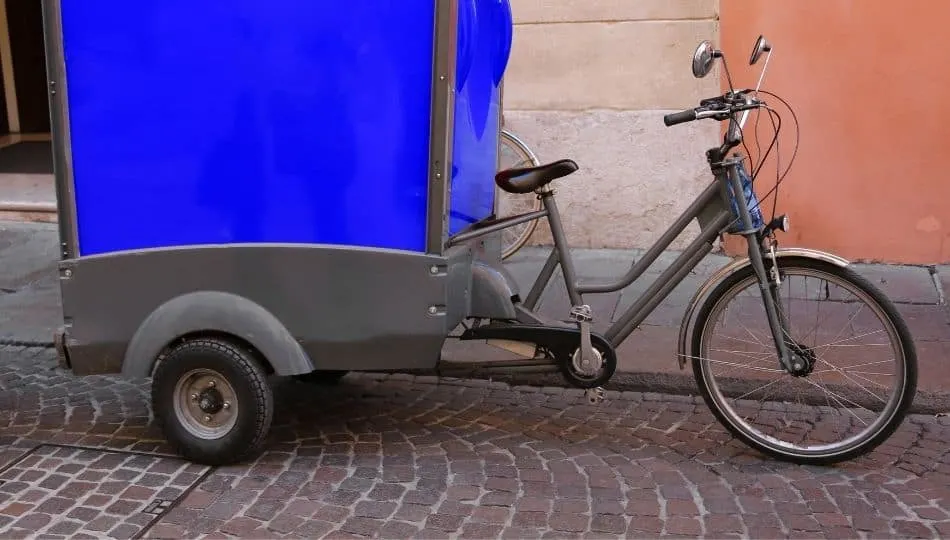
It’s a common misconception that bicycles, being of minute size and ‘frail’ frame compared to their gasoline-powered counterparts, are not suitable for day-to-day tasks and running errands. But you’ll be surprised how much you can actually get done using just your bicycle.
With a bit of planning ahead, bicycles can be used for running many errands such as grocery shopping, making deliveries, or carrying heavier loads. A suitable bicycle, certain bicycle equipment, and a carefully planned route will make running errands on a bike easier.
Many cyclists only learn through trial and error how to successfully run errands on a bicycle, but I’m here to tell you…I’ve made all the mistakes…and I’ve done all the trial and error! So, off the back of that, here are my top tips for your errand-motivated cycling extravaganza…
How to Prepare Your Bicycle Errand Run
Running errands on a bicycle doesn’t have to be complicated, but it does require some planning. In order to maximize your day-to-day efficiency, take these 7 steps to make sure you excel at running errands on the two-wheeled vehicle!
- Choose a bicycle that matches your needs
There are many different types of bicycles; some do a better job at traversing rugged terrain, while others allow you to smoothly speed through city paths. Some are suited to carry heavy loads and large capacities, while other types emphasize travelling efficiency over carrying capabilities.
Check out my article “How to Choose the Perfect Bicycle for You” for more information on the different types of bikes and which one might suit you best.
- Plan out your route
There are many different paths you could take to your destination. You could travel downhill or uphill; through trails or roads; or the main road or a shortcut. It is important to choose the most efficient path for your journey in order to maximize the use of your time.
But at the same time, remember to take into consideration the nature of your journey. Are you going to need to stay on wider paths if you’re carrying bigger items? Will you need to stay on flat ground with minimal inclines because you’re going to have heavy items?
- Plan your time
Don’t forget that riding your bicycle is much slower than driving a car. You should allot extra time for commuting around the city according to the distance to your destination. And then you’ll need extra time on top of that if you’re going to be carrying a heavier load. Give yourself plenty of time to travel.
- Plan your clothing
Travelling on a bicycle means that you will be vulnerable to weather conditions. Ensure that you check the weather forecast before setting off on your errand run and dress accordingly.
- Bring your necessities
Different errands will require different necessities. Remember to bring everything you need with you. An extra bottle of water will never hurt! As well as any extra storage considerations, phone holders, or somewhere for your valuables so that you can be completely hands free.
- Gather your storages and locks
If you need to carry large amounts of luggage, bring a storage system or consider investing in one to attach onto your bicycle. If you would need to leave your bicycle unattended for some time, remember to bring a lock.
How to Choose a Suitable Bicycle To Run Errands
There are many different options for bicycles to choose from. For a bicycle-newbie, choosing the right bicycle may seem like a complicated task, which in reality, isn’t a phony claim. In sum, however, there are only three things to consider…
- The Type of Bicycle
There are 3 main types of bicycles: mountain bikes, road bikes, and hybrid bikes:
- Mountain bikes are optimal for rough, uneven terrain (whether it be off-road or on-road) and for heavy loads.
- Road bikes are optimal for smooth rides at a quick pace and light loads.
- Hybrid bikes are suitable for rides on different terrain, a variety of activities, within commuting traffic and varying weather conditions.

- Features
There are 8 essential features to look out for:
- The handlebars – these will determine the position you ride your bicycle in.
- The frame – this determines the bicycle’s weight and durability.
- The wheels – these will determine the maneuverability of your bicycle.
- The tires – they’ll determine your bicycle’s grip and the efficiency of your pedaling.
- The gears – these will determine your travelling efficiency on different terrain and the weight of your bicycle.
- The brakes – these determine your control over the bicycle.
- The saddle and the suspensions – these determine the comfort of your bicycle.
- Size
There are a few questions to ask yourself when testing for the right bike, all of which are crucial to providing you with the best possible riding experience.
- Are you able to easily hold the handlebars? Ensure that they are not too far and not too close to your abdomen.
- In a riding position, do you have easy access to your brakes at all times during your ride? Full access to the brakes is of utmost importance in ensuring your safety.
- When sitting on your bike, are you able to reach the floor on “tippy toes”? You should be able to stand up and stop yourself at any time.
- When you place your foot at a 2 o’clock position, is your knee directly above your foot? This is the most efficient size for you to propel the bike forward with ease.
My article here walks you through a complete guide to choosing the right bike for yourself.
Planning Out Your Errand Run
Here’s a few tips on how to actually plan out your errand on your bike…
Plan Out Your Route
It is important to plan out which route you plan on taking before you run your errand for two main reasons. Firstly, riding a bicycle is much slower than other forms of transportation; however, if you plan your journey ahead of time, this can save you a lot of time and make your cycling much more efficient.
Secondly, in the case that your journey takes you onto a vehicular road, you may be unable to determine and process the paths you must take. Unlike a car, it is unsafe to use a global positioning system (or GPS) on the move.
Plan Out Your Time
Nobody likes the feeling of being in a rush. Planning out your time enables you to travel at your own pace rather than forcing yourself to pedal as fast as possible to your destination. You’re running errands, not a marathon. On the other hand, this also allows you extra time to “freshen up” after your trip. That’s why it is also recommended to bring along…
Plan Your Clothing
… a spare change of clothes! If you work up a sweat, it allows you to continue your day without being drenched. In some cases, a spare change of clothes keeps you prepared for the weather. Because you aren’t sheltered from the rain nor snow as you would be in a car, it is important that you are dressed for the occasion; it is recommended that you even wear a raincoat or a winter jacket when the weather calls.
If errands frequently take you on long trips, you should consider buying cycling shorts. Riding the bicycle for long periods may make your behind sore; however, cycling shorts can drastically reduce the discomfort and pain you experience the next day!
There are two types: shorts and bibs. The former looks like normal shorts; they are easy to wear, but some people find their tightness uncomfortable. Make sure you try it on first! The latter are shorts held up with braces — like overalls. They are much more comfortable than shorts but less convenient.
Check out my article “Are Cycling Shorts Worth the Money?” to help you decide if it’s worth investing in a pair or not.
Bring the Necessities
The most important thing to bring along is extra water; when you exercise, your body needs water. Feeding your body the necessary fuel and staying healthy is crucial in making the exercise matter. However, don’t bring too much water, it will only weigh you down.
When you’re running your errands, do not wear a backpack. A backpack means that you’re carrying a heavier load, which strains your back, neck and shoulders, but it also means a large patch of sweat on your back.
If you are constantly running errands on a bicycle, it is strongly recommended that you invest in a pannier or a saddlebag. Not only does it have a greater carrying capacity and capability than a backpack, but it also relieves your back from supporting extra weight. (Check out my Recommended Gear section for my favorite storage items.)
However, you may be wondering, “how do I secure my belongings when I have to temporarily leave my bicycle?” Well, you have a few choices. You could consider purchasing a handlebar bag or an inner bag within your pannier, in which you could store your valuables and take them along with you when you must leave your bicycle unattended.
Likewise, you must remember to bring a cable lock or a padlock if you plan on leaving your bicycle unattended. These locks will prevent your bicycle from being stolen when it is out of sight. Usually, they are designed flexible metallic cables that run through your bicycle’s frame and wheel, which are then locked to a bicycle rail.
For more information, check out my article “7 Alternatives to Leaving your Panniers on your Bike”
Final Thoughts
Although some people believe the misconception that bicycles are incomparable to other forms of transportation when running errands on a day-to-day basis, that is false.
With the right preparations, it can even be more efficient than others; not only are you able to fulfill your daily quota of exercise, you are also able to develop a stronger bond and understanding of your surroundings, and in some cases, you could even be quicker because you not stuck in traffic! Just remember: choose the right bicycle for the job, plan out your journey, bring your necessities and get biking!
